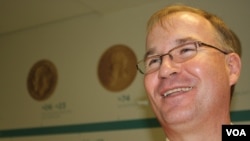Where else but Johannesburg, a city built on the back of a gold rush and home to Africa’s major stock exchange, would there be a monument to money? The Museum of Money is in a building belonging to international banking group, Barclays, in the center of South Africa’s biggest metropolis.
“The beauty of money is you’re dealing with items that have been used, and each coin has a history, it was in someone’s hand. It was used for something,” said Dr. Paul Bayliss, curator of the museum as he strolled past glass cabinets holding thousands of coins from faded, chipped, brass guilders brought to South Africa by Dutch settlers in the 1600s, to dull, dark Portuguese coins recovered from a shipwreck off the Cape coast in the 1400s.
Most old coins are big and very heavy.
“[The coins have] a hole in the middle, allowing someone to put a bit of leather twine through that and hang it around their neck. It’s not something you would really have carried in your pocket, because of the weight,” explained Bayliss.
The museum provides a record of the history of money dating back 4,500 years, to when people exchanged commodities, such as shells.
Bayliss said ancient people bartered with anything they considered to be of value.
“If we think of the San people [of southern Africa], the ostrich egg shell was also quite an important item [to trade with] because that could be used for carrying water or storing water as they migrated [across deserts],” said Bayliss.
The historian said the discovery of diamonds and gold in the mid to late 1800s had the greatest impact on the evolution of money in South Africa.
“That brought in a whole new group of people into the country,” he said.
Inside a vault, overhead lights cause hundreds of brilliant coins to gleam. Armed security officers hover nearby, protecting the valuable collection. Inside are examples of some of the most famous coins in the world: South African Kruger Rands, made of pure gold. The coins bear the image of the long-bearded face of Paul Kruger, President of the South African Republic in the late 1800s.
“The advantage of a Kruger Rand, it allows any individual to own a piece of gold. And from an investment perspective, it allows you to invest in actual gold,” he said.
One of the more unusual exhibits in the museum is what Bayliss called “canvas sack money,” used during the Anglo-Boer War of 1899 to 1902.
“So when the British troops reached [the town of] Upington, there wasn’t actually money in place to be able to pay them. So what the paymaster general did at that time, he literally cut it out of their [the soldiers’] jersey or their jacket or their sacking, and you can actually see a canvas sack bag that has been cut out,” said Bayliss.
Another section of the museum displays old bank notes, dating back to the 1700s, when banks in South Africa began printing them. The notes, in a variety of colors and named after banks that once operated in major South African towns, are large when compared to modern cash.
“It literally would not fit into any wallet and would have to be folded up. And that’s a challenge of a collection like this because in many cases, to find pristine notes of that time it becomes almost impossible,” he said.
But, in assembling one of the greatest collections of money in the world, sourced from all over the globe, the impossible is exactly what Bayliss and his colleagues have achieved.






